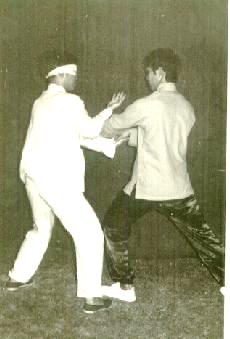ASKING BRIDGE, STICKING HANDS, AND PUSHING HANDS

Chi Sau, or Sticking Hands of Wing Choon Kungfu
Question
What is the difference between Hung Ga “bridge hands”, Wing Cheun “sticking hands”, Taijiquan “pushing hands” and the hand techniques of long range systems like Hap Ga, White Crane, Choi Lei Fat?
-- Sifu Pavel, Czech Republic
Answer
“Asking Bridge” (“Men Kiu”), “Sticking Hands” (“Chi Sau”) and “Pushing Hands” (“Tui Shou”) are some of the ingenious ways in Hoong Ka, Wing Choon and Taijiquan respectively to train combat skills. In these methods, two practitioners keep their forearms in contact, and engage in attacking and defending moves.
The techniques and tactics they use are quite different. Hoong Ka “Asking Bridge” is relatively hard, and focuses on sinking an opponent's bridges. The two practitioners move above in various stances.
Wing Choon “Sticking Hands” are relatively stationary, with both practitioners at the Goat Stance. Their hand movements are fluid and in circles, though attacks usually come in straight lines.
Taijiquan “Pushing Hands” is practiced mainly at the Bow-Arrow Stance. There are two modes, stationary which focuses on developing skills, and mobile which focuses on applying techniques.
Hap Ka, White Crane and Choy-Li-Fatt are famous for their arm techniques, as distinct from using fists, elbows, fingers or palms.
Hap Ka, which means “Knight-Family Kungfu”, is a combination of Lama Kungfu of Tibet and Southern Shaolin, with a predominance on Lama Kungfu. Lama Kungfu makes extensive use of the arms like the long limbs of apes and wide wings of cranes.
There are a few different styles of White Crane Kungfu. The two that use arm techniques widely are the White Crane Kungfu from Tibet, and the White Crane from the Wing Choon District of Fujian Province in South China. Tibetan White Crane is similar to Hap Ka Kungfu where their practitioners swing their powerful arms frequently. They belong to the “long bridge, wide stance” category. Fujian White Crane uses the palms rather than the arms, and is of the “short bridge, narrow stance” category.
While Choy-Li-Fatt practitioners use their arms frequently, they use their fists, tiger-claws and palms extensively too. Choy-Li-Fatt is probably the most “long bridge, wide stance” amongst the Southern styles.
LINKS
